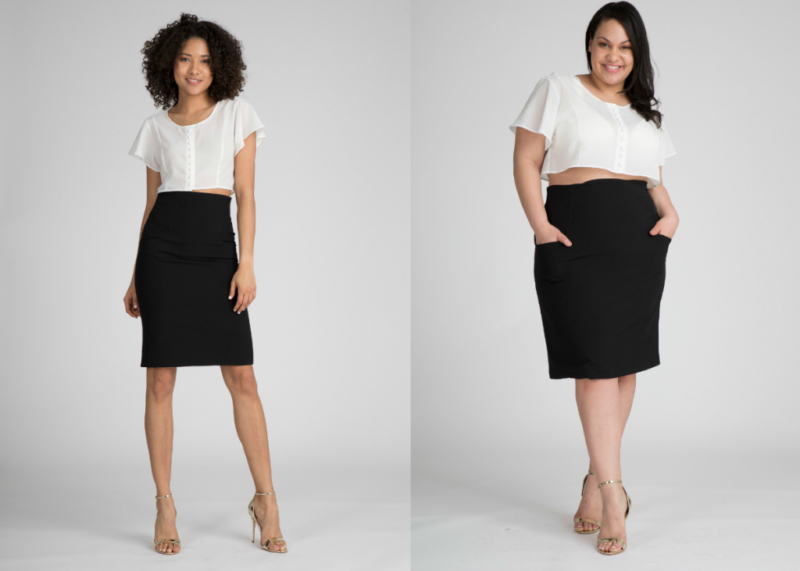It’s 2019, and the world has invented 3D printers that spit out metal and brought artificial intelligence to developing countries. We’ve generated zero-carbon natural gas and created testing that can predict disease from birth. One thing the world has not perfected: providing all women with clothing they love that also comes in their size.
The majority of American women (68 percent) wear a size 14 or above, according to 2018 research from Plunkett Research, which also found that the average size is now between 16 and 18. Not surprisingly, plus-size clothing is big business: U.S. sales of women’s plus-size clothing reached $21.4 billion in 2016, according to market research firm NPD Group. And yet the options available for women who wear a size 14 or above remain dismally inadequate, especially within more specific categories like workwear.
Gita Omri Brown, a New York City-based fashion designer, artist, and writer, is doing her part to expand clothing options for that 68 percent of women. A native of Israel, Brown served in the Israel Defense Forces before coming to New York to study fashion design. Once stateside, she launched two fashion lines that run from sizes 0 to 30—Omri Essentials, a range of more casual, modern staples; and Gita Omri, a collection of luxury womenswear.
Brown considers the majority of her designs workplace-appropriate, even if she does specialize in bold prints and detailed design. She points out that workplace dress codes have evolved over the last decade or more, becoming more casual across a number of fields. Brown, who wears a size 14, sees that shift reflected in the demand for her lines.
“For many, many years, women had to masculinize themselves to be taken seriously,” says Brown, a member at New York’s WeWork 8 W 126th St. A full-time seamstress works alongside Brown in the design studio, with the help of a part-time intern. “You couldn’t run a meeting if you were wearing a pink, frilly dress—you had to show up in that black power suit with shoulder pads. That’s something I tackle with my aesthetic. You can wear whatever you want and still be the boss.”

To be sure, inclusive sizing is on the rise: Independent brands catering to the plus-size demo include design-forward Premme, luxury e-commerce retailer 11 Honoré, and denim brand Good American, which join big-name stalwarts like Eloquii, Asos Curve, and Lane Bryant. Other retailers like J.Crew, Madewell, and Reformation have launched extended sizing throughout their collection or in dedicated capsules. But Brown says these strides are not enough.
“These companies and brands see that ‘plus-size’ is trendy right now. They don’t realize that it should become a part of the structure of their business,” says Brown, who notes that it’s common for brands to merely extend their sizing to a size 18. “Come on. That’s not inclusive. You’re adding two more sizes to your range. If size 16 to 18 is the average, then you’re missing half of all women.”
Brown also questions why certain brands opt to launch a separate collection of plus-size pieces when those sizes should have been included in the original range in the first place. Reformation, for instance, came under fire last spring with the launch of its first 17-piece plus-size collection, designed in collaboration with model Ali Tate Cutler.
And then there’s the matter of terminology. Brown would like to remove ”plus-size” labels altogether to focus on what her brands do first and foremost, which is, quite simply, womenswear. She ensures that her silhouettes are as universally flattering as possible, knowing that there are certain cuts that will work for the majority of body types. Everything else involved in her design process, such as print development and embroidery, stems from those inclusive patterns. This is particularly true in the case of the higher-end Gita Omri, in which the luxury price point—$600 for a dress, for example—falls in line with size-inclusive brands of comparable distribution.
On February 9, Gita Omri will make its New York Fashion Week debut during a show at Metropolitan Pavilion in Manhattan. Brown hopes this presentation will further the conversation about inclusive sizing, while also providing new options for shoppers who haven’t had much luck finding exciting, appropriate clothes in their size.
“I’m a woman and I deserve beautiful fashion,” says Brown. “I deserve to be able to express myself in that way, and it’s not as difficult to create as a lot of designers will have you believe.”







